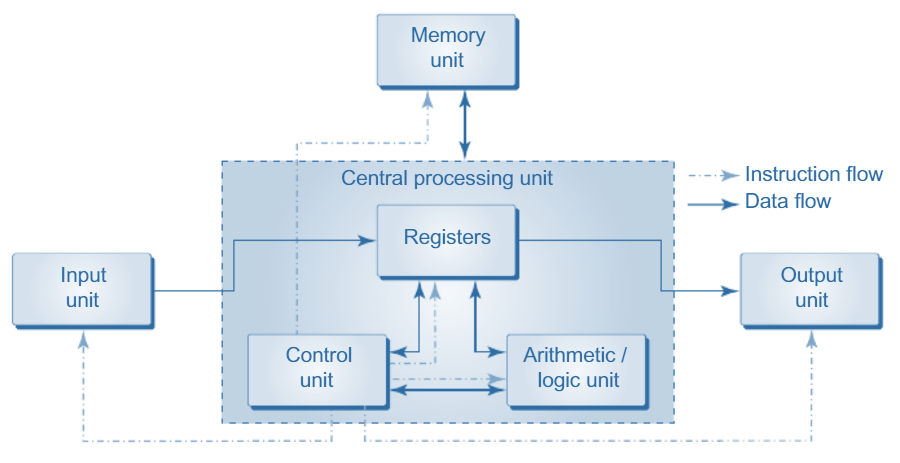
Digital computer and its various components
Table of Content:
A computer can be viewed as a system, which consists of a number of interrelated components that work together with the aim of converting data into information. There are several computer systems in the market with a wide variety of makes, models and peripherals. In general, a computer system comprises four components, namely, central processing unit (CPU), input unit, output unit and storage (or memory) unit. The block diagram of a digital computer is shown in Figure below.

CPU
CPU, also known as ‘processor’, is the brain of the computer system that processes data (input) and converts it into meaningful information (output). It is a highly complex, extensive set of electronic circuitry, which executes stored program instructions. A CPU controls all internal and external devices, performs arithmetic and logic operations, and operates only on binary data, that is, data composed of 1s and 0s. In addition, it also controls the usage of main memory to store data and instructions and controls the sequence of operations. The CPU consists of three main subsystems, which are described as follows:
Arithmetic logic unit (ALU): This unit performs the arithmetic (add, subtract) and logical opera-tions (and, or) on the data made available to it. Whenever an arithmetic or logical operation is to be performed, the required data is transferred from the memory unit to ALU, the operation is performed and the result is returned to memory unit. Before the completion of the processing, data may need to be transferred back and forth several times between these two sections. Subsequently, the results are transferred from internal storage to an output device.
Control unit (CU): This unit checks the correctness of the sequence of operations. It fetches the program instructions from the memory unit, interprets them and ensures correct execution of the program. It also controls the input/output devices and directs the overall functioning of the other units of the computer.
Registers: These are the special-purpose; high-speed temporary memory units that can hold varied information such as data, instructions, addresses and intermediate results of calculations. Essen-tially, they hold the information that the CPU is currently working on. Registers can be considered as the CPU’s working memory, a special additional storage location that provides the advantage of speed
Input and Output Unit
The user must enter instructions and data into the computer system before any operation can be performed on the given data. Similarly, after processing the data, the information must go out from the computer system to the user. For this, every computer system incorporates input and output units that serve as a communication media between the computer system and the user.
An ‘input unit’ accepts instructions and data from the user with the help of input devices such as keyboard, mouse, light pen and so on. Since the data and instructions entered through different input devices will be in different form, the input unit converts them into the form that the computer can under-stand. After this, the input unit supplies the converted instructions and data to the computer for further processing.
The ‘output unit’ performs just opposite to that of input unit. It accepts the outputs (which are in machine-coded form) produced by the computer, converts them into the user understandable form and supplies the converted results to the user with the help of an output devices such as printer, monitor and plotter
Storage Unit
A computer system incorporates ‘storage unit’ to store the input entered through input unit before processing starts and to store the results produced by the computer before supplying them to the output unit. The storage unit of a computer comprises two types of memory/storage, namely, ‘primary’ and ‘secondary’.
The primary memory (also called ‘main memory’) is the part of a computer that holds the instructions and data currently being processed by the CPU, the intermediate results produced during the course of calculations and the recently processed data. While the instructions and data remain in main memory, the CPU can access them directly and quickly. However, primary memory is quite expensive and has a limited storage capacity. Due to limited size of primary memory, a computer employs ‘secondary memory’, which is extensively used for storing data and instructions. It supplies the stored information to the other units of computer as and when required. It is less expensive and has higher storage capacity than the primary memory. Some commonly used secondary storage devices are floppy disks, hard disks and tape drives.